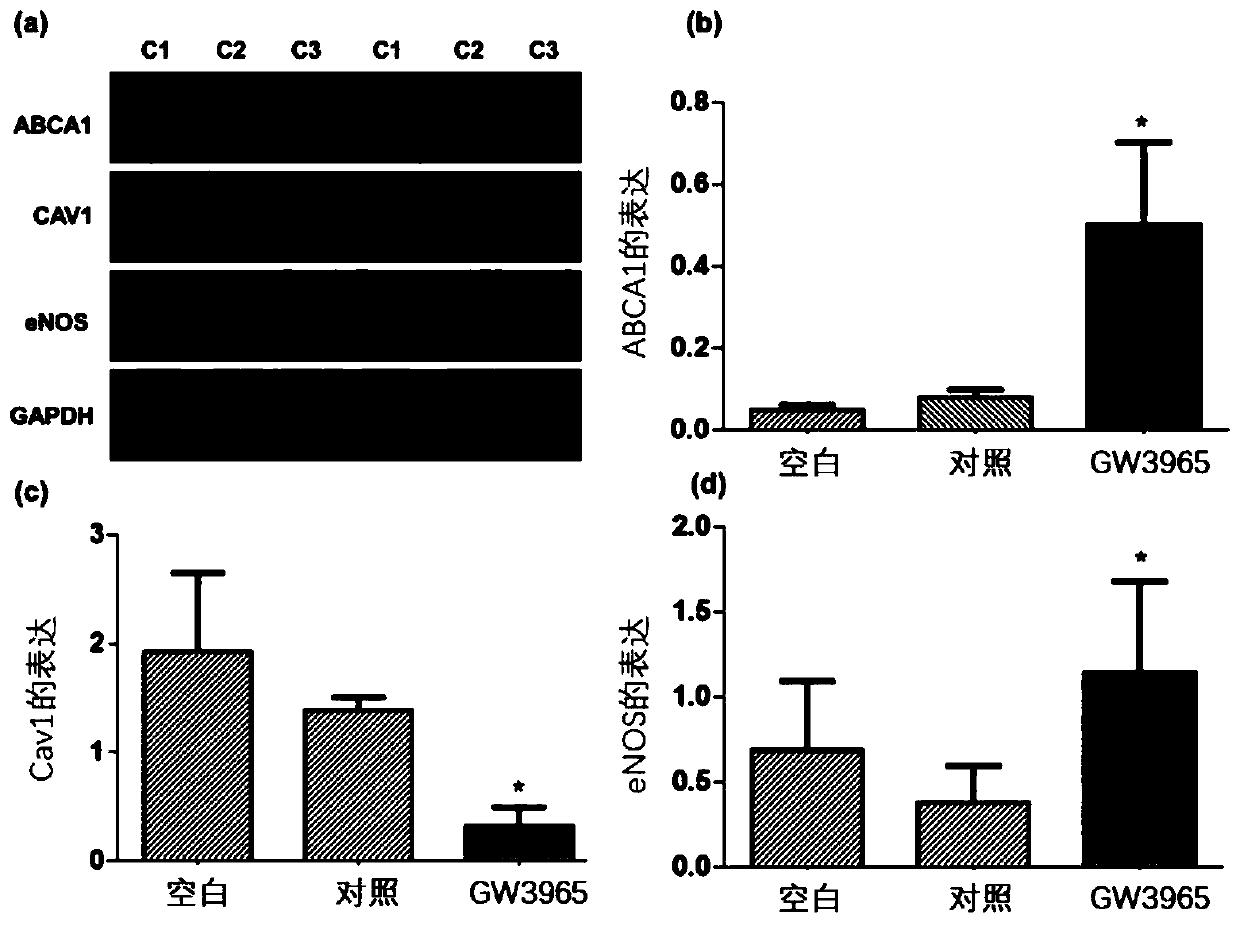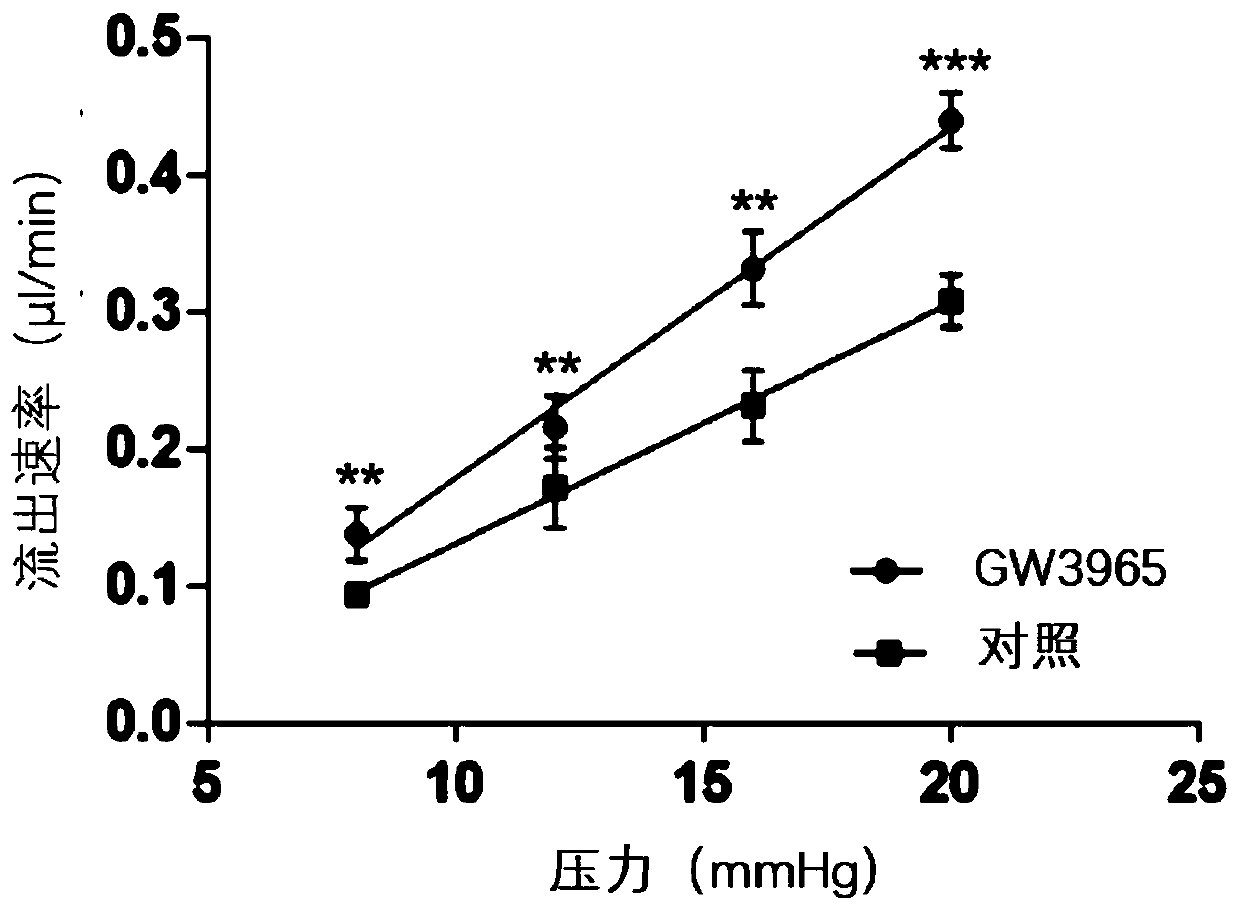Application of ABCA1 agonist in preparation of medicine for treating eye diseases
A technology for eye diseases and agonists, applied in the field of ABCA1 agonists, can solve the problems of poor corneal penetration and short half-life
- Summary
- Abstract
- Description
- Claims
- Application Information
AI Technical Summary
Problems solved by technology
Method used
Image
Examples
Embodiment 1
[0039] Anterior Chamber Injection Experiment of Embodiment 1 WT Mice
[0040] WT mice were anesthetized with ketamine (100 mg / kg) and xylazine (15 mg / kg) by intraperitoneal injection. 2 μl of 100 μM GW3965 solution was slowly injected into the anterior chamber of the mouse's right eye using a Hamilton's 33-G microsyringe. The same dose of DMSO solution was injected into the fellow eye as a control. Immediately after the injection of the drug, the injection needle port was closed with erythromycin ointment. At 0, 6 and 12 hours after injection, intraocular pressure (IOP) was measured using a rebound tonometer (TonoLab, ICare, Espoo, Finland). The intraocular pressure of both eyes was measured 3 times at each time point, and the average value was calculated. At each time point, the intraocular pressure of the experimental eye and the contralateral control eye were compared, with figure 1 It showed that GW3965 100μM injected 2μl in the anterior chamber, 6 hours and 12 hours a...
Embodiment 2
[0041] Example 2 The isolated eyeball perfusion experiment of WT mice
[0042]The aqueous humor outflow rate was measured by perfusing isolated mouse eyeballs according to laboratory established methods. For construction methods, see Lei Y, Overby DR, Boussommier-Calleja A, Stamer WD, Ethier CR. Outflowphysiology of the mouse eye: pressure dependence and washout. Invest OphthalmolVis Sci. 2011;52:1865–1871. Mice were euthanized by cervical dislocation and the eyes were enucleated for perfusion. In order to detect the effect of GW3965, dissolve in DMSO with GW3965, and use 1xPBS (pH7.2-7.4) to dilute to 100 μ M solution and perfuse the eyeball for 60 minutes to exchange the aqueous humor and ensure that the concentration of the GW3965 solution is uniform throughout the experimental process. Eyeballs were then perfused at four different intraocular pressures (8, 12, 16 and 20 mmHg).
[0043] The same concentration of DMSO dissolved in PBS was used as a control, and the control...
Embodiment 3
[0046] Example 3 Western blot experiment
[0047] The porcine angle plexus cell lysates and aqueous humor outflow channel tissue lysates were prepared using RIPA solution (Biyuntian P0013B, Shanghai, China), and the protein concentration was estimated using the BCA protein concentration assay kit (Biyuntian P0010S, Shanghai, China). Equal amounts of proteins were separated by 10% SDS-PAGE (Beyontian P0670, Shanghai, China) (20 μg / lane for porcine angular plexiform cells and mouse outflow tissues, respectively). Electrophoretic transfer of the separated proteins to a nitrocellulose membrane. The membrane was blocked with 5% skim milk powder in Tris-buffered saline containing 0.05% Tween-20 (Sigma-Aldrich, Shanghai, China) at 37°C for 2 hours. Then use specific recognition ABCA1 (1:1000; Abcam, rabbit-derived ab151685, mouse-derived ab18180, Boston, USA), Cav1 (1:1000; Cell Signaling Technology rabbit-derived #3238, USA) or eNOS (1: 1000; Abcam, rabbit-derived ab66127) primary...
PUM
 Login to View More
Login to View More Abstract
Description
Claims
Application Information
 Login to View More
Login to View More - R&D
- Intellectual Property
- Life Sciences
- Materials
- Tech Scout
- Unparalleled Data Quality
- Higher Quality Content
- 60% Fewer Hallucinations
Browse by: Latest US Patents, China's latest patents, Technical Efficacy Thesaurus, Application Domain, Technology Topic, Popular Technical Reports.
© 2025 PatSnap. All rights reserved.Legal|Privacy policy|Modern Slavery Act Transparency Statement|Sitemap|About US| Contact US: help@patsnap.com



